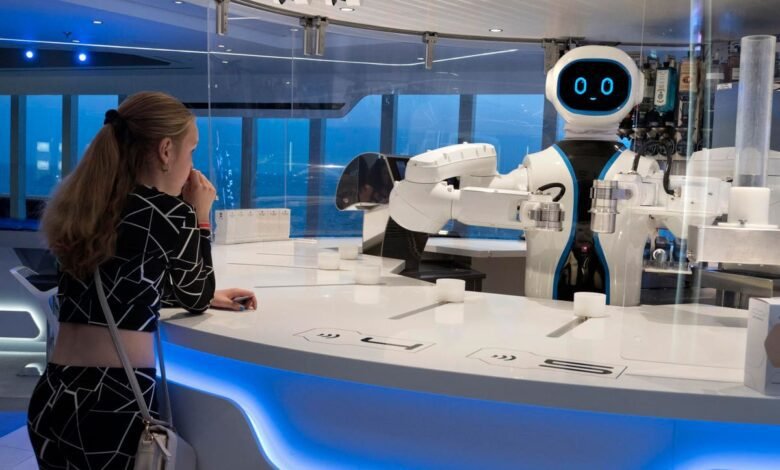The emergence of AI in bartending

Robot bartender on an ocean liner crossing the North Sea. (Photo: Planet One Images/UCG/Universal … [+]
In the vibrant world of bartending, where every cocktail tells a story and every mix is an art, a new chapter is being created by Artificial Intelligence (AI). This is not a story of machines replacing the human touch, but a story in which technology and tradition blend to create a new era of mixology. From AI recommendations to robotic bartenders, this blog explores how AI is not only changing the way drinks are served, but also enriching the very essence of bartending.
AI: the mixologist’s new assistant
Bartending, a craft that combines skill, creativity and understanding flavors, is embracing AI, not as a replacement, but as a complement. AI in bartending is not about removing the bartender; it’s about enhancing their capabilities and offering them new ways to delight their customers. Consider that while there is a wide variety of drink recipes, bartenders are finding that more and more customers are looking for unusual, or at least specialized, drinks based on their individual palettes. This varies not only on the type of alcohol, but also on the level of sweetness, bitterness, peat, etc. In essence, people want a strong level of individual flavor presence for their drinks.
Personalized recommendations: AI as knower
One of the most interesting applications of AI in bartending is in the realm of personalized drink recommendations. AI systems, like those used at Barsys Coaster, analyze customer preferences and past orders to suggest cocktails that align with their tastes. This AI approach adds a personal touch to the bar experience, making customers feel understood and valued. Thus, a glimpse into the future of AI in bartending can be seen with Nino, a robotic bartender developed by Makr Shakr. Nino doesn’t just make drinks; it customizes them based on customer preferences. The robotic arms, with their precision and efficiency, create consistent and personalized cocktails, offering a futuristic touch to the bar experience.
Robot bartenders are becoming more widespread.
Efficiency and consistency: the AI advantage
In busy bars, consistency and speed are key. AI tools like cocktail dispensing systems ensure that each drink is mixed perfectly, with precise measurements and ideal balance. This consistency elevates the quality of service, ensuring that every customer enjoys a high-quality experience, regardless of the bar’s occupancy level. Thus, AI is transforming bartending into a data-driven art. AI-powered systems analyze sales data, popular trends and inventory levels to tell bartenders which drinks are a hit and which ingredients need replenishing. This insight helps bars stay ahead of trends and manage their inventory efficiently.
Perfecting the art of cocktail creation
AI is also getting into the creative side of bartending. IBM’s AI system Watson has been used to create unique cocktail recipes by analyzing thousands of ingredient combinations and identifying combinations that are both new and tasty. This collaboration between AI and human bartenders leads to innovative and exciting new cocktails. Likewise, AI is revolutionizing bartending training. Virtual reality (VR) bartending simulators, powered by AI, offer a realistic training environment where aspiring bartenders can learn and practice their skills. This technology provides a risk-free platform to learn, perfect techniques and experiment with flavors.
Robotic bartenders
In the cruise industry, robotic bartenders like those on Royal Caribbean ships that use the Bionic Bar are demonstrating the potential of AI in bartending. These robots mix drinks ordered via tablets, providing a fun and efficient service that adds a unique element to the cruise experience. In clubs and nightlife venues, they are already turning to tools like iPourIt to streamline the beverage dispensing process. So the future of AI in bartending is not just about mixing precision cocktails but also accelerating the speed of service.
The role of AI in sustainability
Sustainability is a growing concern in the bar industry and AI is playing a crucial role in addressing it. AI systems analyze data to reduce waste, suggesting ways to reuse ingredients and optimize resource use. Additionally, restaurants and bars are using AI to minimize glass usage and waste disposal. This application of AI supports the industry’s movement towards more sustainable and environmentally friendly practices.
AI cyborgs, the new bartender.
Interactive customer experience
AI is enhancing the customer experience by making it more interactive. Bars like Tipsy Robot in Las Vegas use robotic bartenders as an attraction, where customers enjoy the spectacle of their drinks being prepared by robotic arms. This technology integration adds a new and engaging element to the bar experience.
Ethical implications and future perspectives
As AI becomes more integrated into bartending, ethical considerations arise around its employment and preservation of the traditional art of bartending. The key is to find a balance where AI enhances, rather than replaces, the human element, while preserving the art and personal touch that are at the heart of bartending.
The integration of AI into bartending is not just a technological evolution; is a celebration of how tradition can meet innovation to create something extraordinary. In this new era, bartenders are not just practitioners of a craft; they are pioneers at the forefront of a digital revolution in mixology.
Let’s raise our glasses to this era of AI-enhanced bartending, where every cocktail is a fusion of human creativity and technological precision. In this future, bars won’t just be places to drink; they are places of experience, where the charm of the traditional bartender meets the wonders of AI, creating a tapestry of flavors, experiences and innovation. Here, the bartender’s shaker and AI algorithms dance together in harmony, serving drinks that aren’t just drinks, but stories – stories of a future where technology and tradition create magic, one sip at a time.




